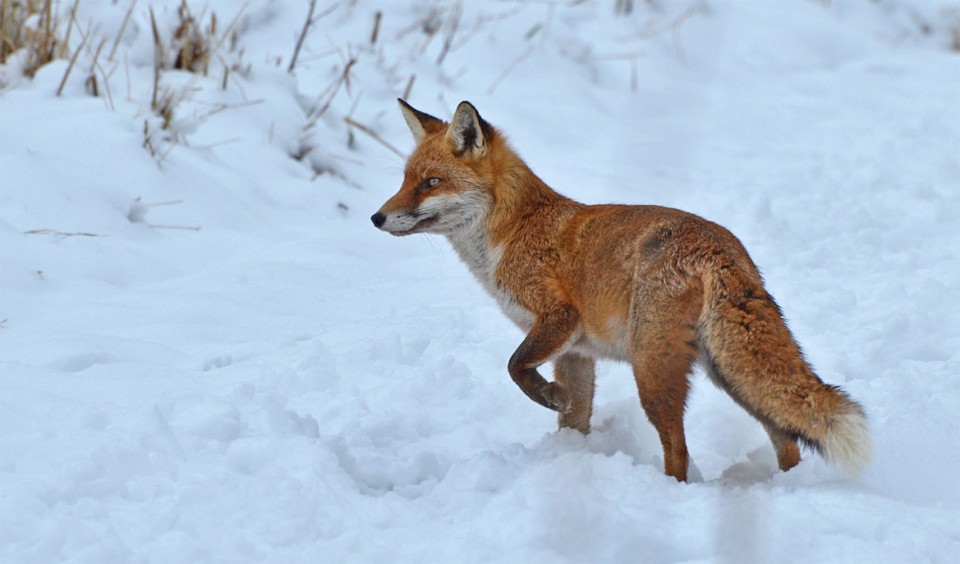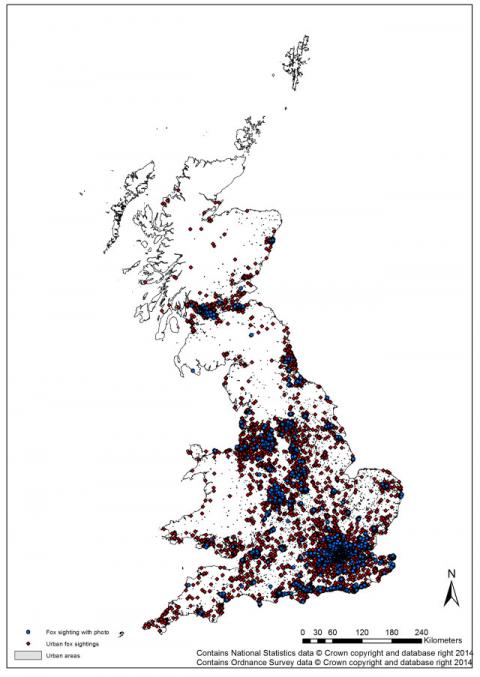Red Fox Abundance & Population
There are no estimates of the global population of Red foxes, although they are widely considered to be the most populous wild canid. The number of foxes in a given area is controlled by several factors (see QA), although three seem particularly important: food availability; suitable den sites; and predators/competitors (particularly other larger canids such as coyotes and dingoes). In some areas populations are regulated by social factors, although this tends to be only when other factors (e.g. food) aren’t limiting. Similarly, the severity of the winter has been shown to impact fox abundance, with the milder winters at lower latitudes supporting larger fox populations.
The percentage of open areas also influences fox density, with fewer foxes in dense forests (i.e. those with 80% or more tree cover) and numbers increasing as the percentage of open land increases. According to one Russian study, the spread of foxes seems to be favoured by forests with 30% to 60% open areas. In short, fox populations aren’t uniform; instead they vary according to the hospitality of the local environment. Below is a very brief summary; please refer to the QA on fox numbers for a more thorough analysis.
Abundance: foxes per unit area
Fox abundance varies with habitat, with the lowest densities (fewer than one animal per sq-kilometre) found in conifer forests/plantations and open fields. Densities are higher in deciduous woodland and on agricultural land (1-2 per sq-km), with yet more in the suburbs (2-3 per sq-km) and the highest densities (four or more per sq-km) in urban areas, particularly large cities. There is considerable variation and densities of three foxes per sq-km may be found in highly productive mixed farmland.

The British fox population also shows considerable variation in abundance according to habitat, with densities generally ranging from about one fox per four sq-km, to four (or more) per sq-km; the average is about two animals per sq-km. A study of one area of mixed deciduous woodland in the New Forest in Hampshire, published in May 1974, estimated about two foxes per square kilometre (ca. 5 per sq-mile). In a paper to the Journal of Zoology during 2000, a team of biologists at the Game Conservancy Trust in Hampshire presented pre-breeding density estimates of 0.41 fox per sq-km, 1.2 per sq-km and 0.16 per sq-km for rural mid-Wales, east Midlands and East Anglia, respectively. There are, however, extremes – from one breeding pair per 40 sq-km (15.5 sq-mi) in hill areas of Scotland, to the largest population density ever recorded (37 foxes per sq-km) in Bristol city during the early 1990s.
The Pitsea Landfill site in Essex that featured on the BBC’s Springwatch a few years ago boasts a high density of foxes – a student who looked at fox dynamics on the site on behalf of the resident naturalist, Phil Shaw, estimated a density of one fox per eight hectares (approximately 12.5 foxes per sq-km, or 32.4 foxes per sq-mile). Again, this illustrates how a readily available food supply can significantly influence fox abundance. In December 2016, Dawn Scott at Brighton University and colleagues presented their analysis of Britain’s fox population to the Ecological Society’s meeting in Liverpool. Their data suggest Bournemouth topped the list of cities with the highest fox densities at 23 foxes per sq-km (60 per sq-mi); London had 18 (47); Brighton 16 (41); and Newcastle 10 (26) per sq-km (sq-mile).
In 2007, Polish mammologists Kamil Barton and Andrzej Zalewski surveyed the literature on fox populations in Eurasia and found that winter density ranged from 0.001 to 2.8 animals per sq-km, with an average density of 0.21 per sq-km. In other words, the range was one fox per 1,000 sq-km (386 sq-mi) to almost three foxes per sq-km, with an average of one fox per five sq-km (2 sq-mi). In northern Europe densities are typically one fox per three-or-five sq-km while, in Spain, densities are around one fox per three-quarters sq-km.

Generally-speaking, the highest stable fox densities are found in the most heterogeneous (diverse) habitats, so urban and arable areas can support two or more foxes per sq-km, while relatively barren upland regions rarely exceed one fox per five sq-km. Indeed, a recent paper to the journal Acta Theriologica by German biologists reported fox densities in settlements that were three- to eight-times higher than those in "strictly rural" of southern Germany.
In homogenous (uniform) habitats densities can be high, but are more prone to cyclical fluctuations in accordance with prey. How prone to fluctuation a fox population is depends on the species on which it can feed. In heterogeneous habitats foxes can switch to a different species when one declines; this is not the case in homogenous habitats where voles are often the main (sometimes only) source of food, so fox populations fluctuate with the number of voles. There are occasions where homogenous habitats can sustain high fox densities. Working in Sweden during the late 1960s, for example, Jan Englund found that fox populations in southern areas, where rabbits were found, were steadier in number and breeding success than those in northern areas, which are dominated by rodents.

The data on fox abundance in North America is patchier than for Europe. There are, as far as I know, no recent estimates (most sources refer to those given by Dennis Voigt in 1987), but those that do exist suggest that fox density typically ranges from one animal per ten sq-km (4 sq-mi) in less productive areas (arctic tundra and boreal forests, for example), to one animal per sq-km in more productive agricultural landscapes. Locally, however, densities may be higher, with an estimated ten animals per sq-km on Round Island, Alaska in 1989. In a 1991 paper, Rick Rosatte and colleagues estimated the fox population of metropolitan Toronto to be about 1.3 animals per sq-km. In much of North America coyotes (Canis latrans) are an increasingly common sight in urban areas; coyotes are known to displace foxes and their presence could account for lower fox densities here than in urban Britain.
All together now: total fox population size

Total numbers are far more difficult to estimate than population density; hence few attempts have been made. The most recent published census (conducted between 1999 and 2000) estimated that Britain has a stable population of around 230,000 animals (before cubs are born); a further 150,000-or-so are estimated to be in Ireland.
The Mammal Society, in conjunction with the Animal and Plant Health Agency, are working on revised population estimates and distribution maps of Britain’s mammal species. Published in 2017, provisional results of the Red fox by National Wildlife Management Centre biologist Graham Smith and his colleagues provide an estimate of the British fox population based on data from the NBN Gateway project and average fox density per habitat type. Their analysis estimates that there are some 430,515 Red foxes in the UK, although the authors do note “there is also uncertainty surrounding the estimate”.
In 2011, the ‘official’ UK urban population guestimate stood at about 33,000 animals, although this this figure comes from a study published in 1995. I have heard figures of between 10,000 and 30,000 foxes in the London area alone, but know of no supporting data for these 'estimates'. More recently very preliminary analysis of a survey of just over 11,000 respondents from across the country, completed as part of the Foxes Live series shown on Channel 4 during May 2012, led Dawn Scott and Phil Baker (at Reading University) to tentatively estimate 35,000 to 45,000 foxes living in urban Britain. A more rigorous analysis using computer models to interpret almost twice as many survey responses, tracking data and habitat mapping suggested a much higher figure.
At the Ecology Society’s conference in 2016, Scott presented an estimate of 150,000 urban foxes in Britain. Perhaps most interestingly, Scott and her colleagues observed that there was no significant correlation between the average fox density and the number of sightings. In other words, seeing more foxes around isn't necessarily an indication that there are more (or even a lot of) foxes in your neighbourhood.
The latest (2015) data from the Peoples' Trust for Endangered Species Mammals on the Roads and Living with Mammals surveys suggest that we're seeing about the same number of foxes killed on the roads and visiting our gardens now as we were back in the early 2000s, while the results of the 2015 British Trust for Ornithology Breeding Bird Survey (which also counts mammals) suggests that fox abundance in the UK as a whole has actually declined by about one-third since 1996. In an article to the New Scientist in January 2017, Philip Stephens of Durham University noted that there is anecdotal evidence to suggest:
“… since the hunting with dogs ban came into force, gamekeepers have felt a particular obligation to hammer foxes as hard as they can.”

Further afield: numbers outside Britain
To the best of my knowledge, there are no estimates of the total European population, nor of that in North America. In Australia it is equally difficult to assess fox numbers because the diversity of habitats and seasonality is arguably greater than in the UK; that said, estimates of 7 million animals have been put forward. Australian fox biologist Clive Marks told me that:
“The Australian environment is so variable in habitat and habitats change in carrying capacity due to season and drought/boom and bust cycles etc making any one figure meaningless; much more than for the UK I would guess – that is not subject to extreme changes.”
Indeed, density estimates for Australian foxes are ordinarily restricted to simply ‘rare’, ‘common’ or ‘abundant’, although some figures have been published. In a 2006 report by Natural Resources and Water (a department of the Queensland government), Matt Gentle of Biosecurity Queensland wrote:
“Studies in Australia have shown that fox density varies considerably by habitat. Densities range between 0.9 foxes per km2 in arid areas, between 1.2–7.2 per km2 in fragmented agricultural habitats, and up to 16 per km2 in urban areas.”
Data compiled by the Invasive Animals Cooperative Research Centre for 2007, suggest that foxes are most abundant in the south (particularly the south-east, around the Eyre Peninsula, Port August, Adelaide, etc.) as well as parts of New South Wales (including Ivanhoe, Sydney, Cooma and Gunnedah). In March 2017, Invasive Animals CRC Project Manager Peter West told me:
“The distribution of foxes doesn’t change much – they’ve pretty much spread to their max extent … Even if numbers go up and down based on conditions of the land, there doesn’t seem to be enough of a priority to measure those changes, remembering that large areas of Aust are uninhabited.”
To the best of my knowledge, there are few data on the population density and distribution for foxes across Asia, although there are some well-known areas of conservation concern, despite the species being rated as of "Least Concern" and with a globally stable population by the 2016 IUCN Red List of Threatened Species report.
Once known throughout Korea, except Ulleung Island of Gyeongsangbuk-do and Jeju-doIn, the Red fox is now listed as a "Class I endangered species" by the Ministry of Environment of Korea South Korea. It's listing as an endangered species, followed it being declared "extinct in nature", around 1980 after the killing foxes to protect livestock and the demand for fur has exacerbated mortality from secondary poisoning caused by a nationwide rodenticide program and habitat loss/fragmentation. Despite a dead fox being found in Yanggu-gun, Gangwon province, wild foxes have not been seen in South Korea since the 1980s and, in 2011, the Korean government initiated a project to restore the fox population in Sobaeksan National Park, which is still underway.
See associated QA for more details on how we estimate fox numbers.